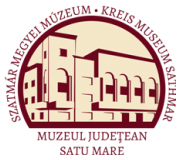Kiss Imola - Szőcs Péter Levente (szerk.): Arhitectura religioasă medievală din Transilvania (Satu Mare, 1999)
Emődi Tamás: Cercetări efectuate la Biserica reformată din Săcuieni (jud. Bihor)
202 5. Fragmente arhitecturale romanice din sec. al XII-lea descoperite în fundaţia navei gotice (1-2).şi în gardul palatului Stubenberg. (3-6) 5. Romanesque architectural fragments from the XII'1' century, found at the foundation of the gothic nave (1-2) and in the garden of Stubenberg palace (3-6) 6. Fragmente arhitecturale provenite din biserica gotică 6. Arhitectural fragments from the gothic church 7. Reconstrucţia grafică a tabernacolului 7. Graphic reconstruction of the tabernacle 8. Portalurile gotice ale bisericii (1. portalul vestic; 2. portalul sudic) 8. The gothic portals of the church (I. western, 2. southern) 9. Elementele sistemului de boltire şi reconstrucţia lui 9. Elements of the vault system and their reconstruction 10. Planul bisericii. Fazele de construcţie 10. Layout of the church. Building phases The archeological historical investigation of the calvinist church at Sdcuieni (Bihor county) (Summary) The settlement, which is to be found on the medieval route between Oradea and Satu Mare, was first mentioned by written sources in 1278 as Zekulhvd. Its name can be interpreted as a proof of the presence of the székelys in Bihor county from the X-XIth century. During the Xlllth and the XIVth century it is owned successively bv the Gutkeled family - having Swabian origins - (before 1241 and between 1317-1402), by governor Pál Gereg\>e and his sons (1242-1278) respectively by Roland Borsa, voivod of Transylvania (1278-about 1317). In 1402 it is given by king Sigismund of Luxemburg to the Zólyomi of Albis family, building important estates in the region. Under their possession during the XVth century the settlement develops into a market town gaining the rights of holding fairs, and a fortress is built in it in 1460. In the spring of 1996 in connection with renovation and drainage work and replacement of the floor covering a partial architectural investigation of the church was made. It has brought important results that could be summarised the following way: the foundations of a Romanesque parish church with square apse, which was built in the second half of the Xlllth century, were found. The northern nave-wall can be seen included in the walls of the present calvinist church. Its pastor is mentioned between 1291-1294 and later betw>een 1333-1335 by the papal tithe inventory. Nevertheless the earliest architectonic fragments - one of them is a plinth of a twin coloumn - founded in the ruins could be dated to the Xllth century. They should belong to an earlier parish church or perhaps to the Egyed monastery - dedicated to the All Saints - built by the Gutkeled family in the Xllth century and located about 10 km far from Sdcuieni. Important changes are made on the church under the Zólyomis: its nave is lenghten toward west, a new gothic apse with semidecagonal ending and buttresses is built and a sacristy in the north part as well. The layout with corner-in-the-axis spreads in the second half of the XIVth century in Central Europe, mainly in Czehia, but we have a few examples
